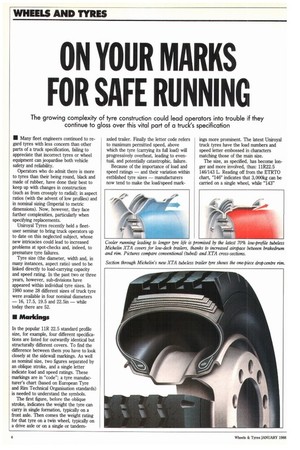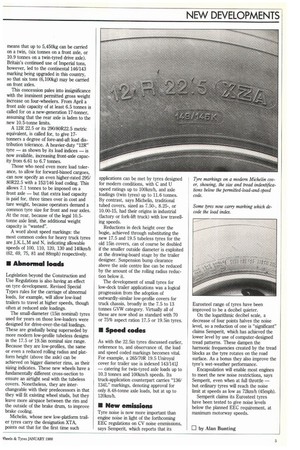ON YOUR MARKS FOR SAFE RUNNING
Page 92

Page 93

If you've noticed an error in this article please click here to report it so we can fix it.
The growing complexity of tyre construction could lead operators into trouble if they continue to gloss over this vital part of a truck's specification
• Many fleet engineers continued to regard tyres with less concern than other parts of a truck specification, failing to appreciate that incorrect tyres or wheel equipment can jeopardise both vehicle safety and reliability.
Operators who do admit there is more to tyres than their being round, black and made of rubber, have done their best to keep up with changes in construction (such as from crossply to radial); in aspect ratios (with the advent of low profiles) and in nominal sizing (Imperial to metric dimensions). Now, however, they face further complexities, particularly when specifying replacements.
Uniroyal Tyres recently held a fleetuser seminar to bring truck operators up to date on this neglected subject, whose new intricacies could lead to increased problems at spot-checks and, indeed, to premature tyre failures.
Tyre size (the diameter, width and, in many instances, aspect ratio) used to be linked directly to load-carrying capacity and speed rating. In the past two or three years, however, sub-divisions have appeared within individual tyre sizes. In 1980 some 28 different sizes of truck tyre were available in four nominal diameters — 16, 17.5, 19.5 and 22.5in — while today there are 52.
• Markings
In the popular 11R 22.5 standard profile size, for example, four different specifications are listed for outwardly identical but structurally different covers. To find the difference between them you have to look closely at the sidewall markings. As well as nominal size, two figures separated by an oblique stroke, and a single letter indicate load and speed ratings. These markings are in "code"; a tyre manufacturer's chart (based on European Tyre and Rim Technical Organisation standards) is needed to understand the symbols.
The first figure, before the oblique stroke, indicates the weight the tyre can carry in single formation, typically on a front axle. Then comes the weight rating for that tyre on a twin wheel, typically on a drive axle or on a single or tandem
axled trailer. Finally the letter code refers to maximum permitted speed, above which the tyre (carrying its full load) will progressively overheat, leading to eventual, and potentially catastrophic, failure.
Because of the importance of load and speed ratings — and their variation within estblished tyre sizes — manufacturers now tend to make the load/speed mark
ings more prominent. The latest Uniroyal truck tyres have the load numbers and speed letter embossed in characters matching those of the main size.
The size, as specified, has become longer and more involved, thus: 11R22.5 146/143 L. Reading off from the ETRTO chart, "146" indicates that 3,000kg can be carried on a single wheel, while "143" means that up to 5,450kg can be carried on a twin, (six tonnes on a front axle, or 10.9 tonnes on a twin-tyred drive axle). Britain's continued use of Imperial tons, however, led to the continental 146/143 marking being upgraded in this country, so that six tons (6,100kg) may be carried on front axles.
This concession pales into insignificance with the imminent permitted gross weight increase on four-wheelers. From April a front axle capacity of at least 6.5 tonnes is called for on a new-generation 17-tonner, assuming that the rear axle is laden to the new 10.5-tonne limits.
A 12R 22.5 or its 290/80R22.5 metric equivalent, is called for, to give 17touters a degree of fore-and-aft load distribution tolerance. A heavier-duty "12R" tyre — as shown by its load indices — is now available, increasing front-axle capacity from 6.61 to 6.7 tonnes.
Those who need even more load tolerance, to allow for forward-biased cargoes, can now specify an even higher-rated 295/ 80R22.5 with a 152/146 load coding. This allows 7.1 tonnes to be imposed on a front axle — but that extra load capacity is paid for, three times over in cost and tare weight, because operators demand a common tyre size for front and rear axles. At the rear, because of the legal 10.5tonne axle limit, the additional weight capacity is "wasted".
A word about speed markings: the most common codes for heavy truck tyres are J,K.L,M and N, indicating allowable speeds of 100, 110, 120, 130 and 140km/h (62, 69, 75, 81 and 88mph) respectively.
• Abnormal loads
Legislation beyond the Construction and Use Regulations is also having an effect on tyre development. Revised Special Types rules for the carriage of abnormal loads, for example, will allow low-load trailers to travel at higher speeds, though often at reduced axle loadings.
The small-diameter (15in nominal) tyres used for years on those low-loaders were designed for drive-over-the-tail loadings. These are gradually being superseded by more modern low-profile tubeless designs in the 17.5 or 19.5in nominal size range. Because they are low-profiles, the same or even a reduced rolling radius and platform height (above the axle) can be achieved on bigger diameter rims, as their sizing indicates. These new wheels have a fundamentally different cross-section to ensure an airtight seal with the tubeless covers. Nonetheless, they are interchangeable with their predecessors in that they will fit existing wheel studs, but they leave more airspace between the rim and the outside of the brake drum, to improve brake cooling.
Michelin, whose new low-platform trailer tyres carry the designation XTA, points out that for the first time such applications can be met by tyres designed for modern conditions, with C and U speed ratings up to 100Iun/h, and axle loadings (twin tyres) up to 11.6 tonnes. By contrast, says Michelin, traditional tubed covers, sized as 7.50-, 8.25-, or 10.00-15, had their origins in industrial (factory or fork-lift truck) with low travelling speeds.
Reductions in deck height over the bogie, achieved through substituting the new 17.5 and 19.5 tubeless tyres for the old 15th covers, can of course be doubled if the smaller outside diameter is exploited at the drawing-board stage by the trailer designer. Suspension bump clearance above the axle centre line can be reduced by the amount of the rolling radius reduction below it.
The development of small tyres for low-deck trailer applications was a logical progression from the adoption of outwardly-similar low-profile covers for truck chassis, broadly in the 7.5 to 13 tonnes GVW category. Virtually all of these are now shod as standard with 70 or 75% aspect ration 17.5 or 19.5in tyres.
• Speed codes
As with the 22. Sin tyres discussed earlier, reference to, and observance of, the load and speed coded markings becomes vital. For example, a 265/70R 19.5 Uniroyal cover for trailer use is indexed 143/141J — catering for twin-tyred axle loads up to 10.3 tonnes and 1001un/h speeds. Its truck-application counterpart carries "136/ 134L" markings, denoting approval for only 8.48-tonne axle loads, but at up to 120km/h.
• New emissions
Tyre noise is now more important than engine noise in light of the forthcoming EEC regulations on CV noise ernmissions, says Semperit, which reports that its Eurosteel range of tyres have been improved to be a decibel quieter.
On the logarithmic decibel scale, a decrease of four points halves the noise level, so a reduction of one is "significant" claims Semperit, which has achieved the lower level by use of computer-designed tread patterns. These dampen the harmonic frequencies created by the tread blocks as the tyre rotates on the road surface. As a bonus they also improve the tyre's wet-weather performance.
Encapsulation will enable most engines to meet the new noise restrictions, says Semperit, even when at full throttle — but ordinary tyres will reach the noise limit at speeds as low as 72km/h (45mph).
Semperit claims its Eurosteel tyres have been tested to give noise levels below the planned EEC requirement, at maximum motorway speeds.
El by Alan Bunting




















































































































